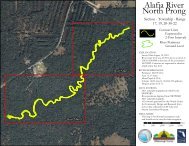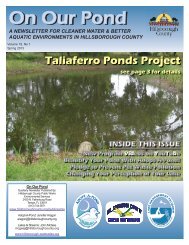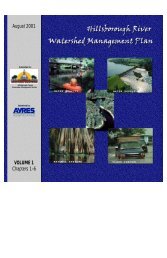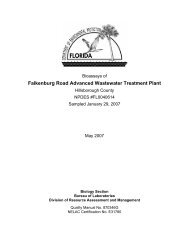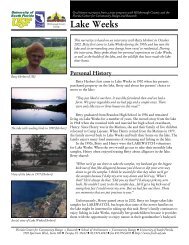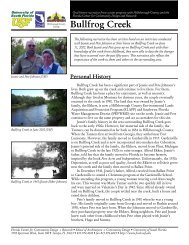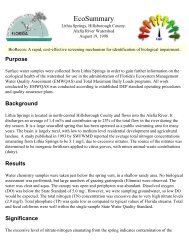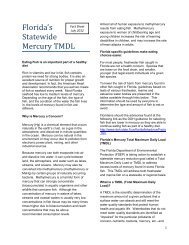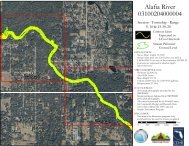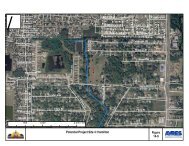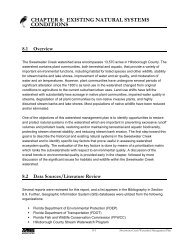Rocky Brushy Creek Watershed Mgmt. Plan (2007) -- Part 2
Rocky Brushy Creek Watershed Mgmt. Plan (2007) -- Part 2
Rocky Brushy Creek Watershed Mgmt. Plan (2007) -- Part 2
Create successful ePaper yourself
Turn your PDF publications into a flip-book with our unique Google optimized e-Paper software.
EXISTING NATURAL SYSTEMS CONDITIONSChannel AlterationsWith the growing need for space for human use, natural channels in the watershed have beendredged, straightened, and/or filled to serve as water conveyances for stormwater, resulting in lossor reduction in ecological value. Channelization has also resulted in degraded water quality instreams allowing exotic species like water hyacinth to compete with native species. Increasedstormwater runoff and removal of bank vegetation in these ditch systems have resulted insedimentation and eutrophication, altering the aquatic species that utilize the system. Non-nativeand/or nuisance aquatic species more tolerant of anoxic or poor water quality conditions dominatethese waterways which decreases biological diversity. In the <strong>Rocky</strong>/<strong>Brushy</strong> <strong>Creek</strong> watershed,channel alterations have occurred throughout the watershed at various locations, including: majorroadway crossings (Old Memorial Highway, Linebaugh Avenue, Ehrlich Road, Waters Avenue,Veterans Expressway, Sheldon Road); minor crossings in subdivisions; at the Channel A cutoffsouth of Linebaugh Avenue; at railroad grades south of Linebaugh Avenue; and electricaltransmission line and water pipeline exiting Section 21 wellfield.Water Supply ImpactsComponents of one water production facility are located in the <strong>Rocky</strong> <strong>Creek</strong> - <strong>Brushy</strong> <strong>Creek</strong>watershed: wells, pipelines, and the pumping facility associated with the Cosme-Odessa Wellfield.The primary impacts have been: (1) habitat disturbance and elimination to accommodate thewellfield, (2) reduction of hydroperiods in nearby wetlands, and (3) reduction in water elevations innearby lakes.8.5.7 WildlifeThe information for this section was developed from previous surveys conducted by HillsboroughCounty and ELAPP staff, FFWCC (1992) FNAI Species Occurrence records, and staff experiencein the area. Review of compiled fauna indicates that 25 species of fish, 38 species of amphibiansand reptiles, 169 species of birds, and 39 species of mammals potentially utilize the watershed.Notable species include the protected species listed in Table 8-9.8.5.8 Protected SpeciesMany native fauna and flora are protected from activities that harm or interfere with them or theirhabitat by federal, state, and local regulations. Fauna and flora are federally protected by theUSFWS under Title 50 Code of Federal Regulations (CFR) 17 and 23. Federally protected speciesare categorized as threatened or endangered. State protection of fauna is administered by theFWC under F.A.C., Rules 39-27.003, 39-27.004, and 39-27.005. The Florida Department ofAgriculture and Consumer Services administers F.A.C., Chapter 5B-40. State protected floralspecies are categorized as commercially exploited, threatened, or endangered. Managementstrategies still needed to be developed to protect these species, including coordination efforts withFlorida Natural Areas Inventory (FNAI), FWC, and USFWS. Hillsborough County EPC indirectlyprotects these species by protecting wetland habitats essential to the survival of these species. Inaddition, the County’s upland habitat ordinance provides protection of essential habitats.8-32<strong>Rocky</strong>/<strong>Brushy</strong> <strong>Creek</strong> <strong>Watershed</strong> Management <strong>Plan</strong>



